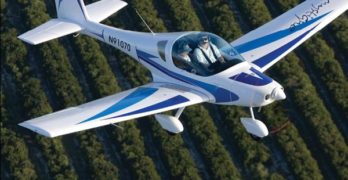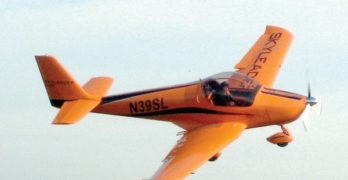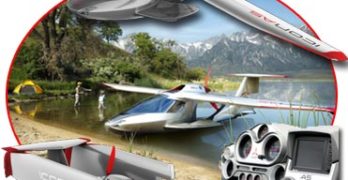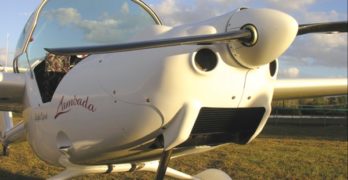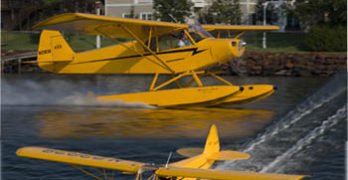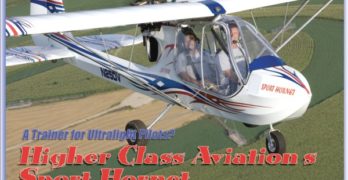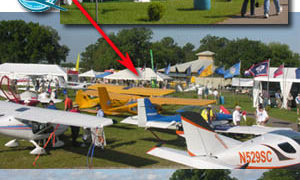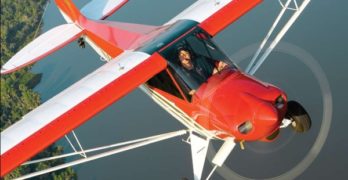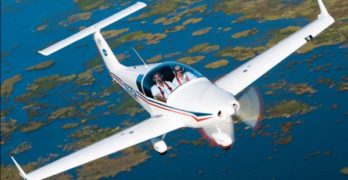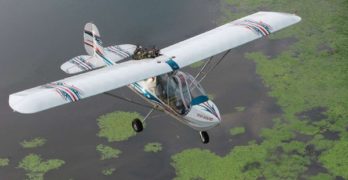But this airplane offers no mystery …
Most pilots will find
nothing mysterious
about the Mystique. In
fact, many readers already
know its manufacturer,
Interplane Aircraft, which
also manufactures the
Skyboy that achieved early
success before light-sport
aircraft (LSA) were given
official status.
Yet to American pilot
eyes, the Mystique is a
new bird on the horizon.
It earned its special lightsport
aircraft (S-LSA)
airworthiness certificate
shortly before the U.S.
Sport Aviation Expo in
mid-January 2007. This is
the second S-LSA approval
for Interplane; Skyboy won
approval in October 2006.
Let’s Meet the Distributor and Manufacturer
Many LSA pilots have come to
know Doug and Betty Hempstead,
the proprietors of several aviation
companies based at the Sanford-Lee
County Regional Airport in North
Carolina. Doug and Betty operate a
flight school, two import enterprises,
and plan to embark on final assembly
of airplanes in the United States.
The Hempsteads import the Allegro,
manufactured in the Czech
Republic by Fantasy Air, under the
Fantasy Air USA name.
Search Results for : MG 21
Not finding exactly what you expected? Try our advanced search option.
Select a manufacturer to go straight to all our content about that manufacturer.
Select an aircraft model to go straight to all our content about that model.
SkyLeader’s Wide-Body LSA
Update Note (2021) — This article published in 2008. The aircraft was then referred to as Skyleader 500. Later this was further upgraded and became the Skyleader 600. Obviously, some information presented below will be dated but much of the flight qualities reporting is still useful. —DJ
Sky Leading KP-5
First, Americans became aware of Kappa. This corporate identity was more easily pronounced than the next company name,
Jihlavan (roughly, “YEE-lah-von”) Airplanes. Now, after new investment and with new global ambitions, the company will be known a “Skyleader Aircraft.” American tongues can relax with this easy reference.
Unchanged are a common owner and the same skilled Jihlavan Airplanes
technicians building the elegant KP-5/Skyleader 500 from the Czech
Republic. It may not be the biggest seller among light sport aircraft (LSA),
but I find it to be one of the finest flying machines in the fleet. Skyleader
plans to standardize the brand around the world and will rename the KP-5
the Skyleader 500.
Not Your Father’s LSA; Icon A5 Grand Unveiling
One glance at almost any view of the Icon A5 will tell you this isn’t like any Light-Sport Aircraft you’ve ever seen. Oh, the Nexaer was shapely and showed innovative thinking. And certainly, we have many fine LSA on the market. Yet nothing I’ve seen compares to the Wow! factor that comes when your eyes feast on A5. *** In a grand ceremony attended by 550 invited persons at company headquarters near LAX airport, Icon finally pulled the concealing drapery off their new LSA. Unless you’re a contractor assisting Icon, you’ve probably never heard about the project, a tightly-guarded secret. *** This idea was given birth at Stanford University by F-16 fighter jock, Kirk Hawkins. He’s enlisted as impressive a team as I’ve seen since Cirrus burst on the market exactly 10 years ago. For example, Icon’s engineering staff is composed of the top people from Burt Rutan’s Scaled Composites.
Lambada’s Choice
Motor Along Economically
Not all light sport aircraft (LSA) are made alike.
You probably knew that already, but consider
the Lambada. This sleek composite 2-seat
shoulder wing is part airplane, part glider and it has
the interchangeable wing tips to prove it.
For a soaring enthusiast like myself, flying the
Lambada gratified a desire I’ve had for years, since I
first saw the Urban Air design at a German airshow. On
January 9, 2008, I went aloft in a Lambada with Josef
Bostik – a former U.S. National Champion hang glider
pilot turned airline captain – at Wallaby Ranch, an
iconic hang glider park in Central Florida where hang
gliders are towed aloft behind specially built ultralights.
The particular Lambada I flew bore N-number
N109UA. Bostik indicated that 108 other Lambada
aircraft are flying around the world, though the
one I flew is the first ’08 model to pass ASTM standard
certification.
Floatplane Season Means Fun for LSA Enthusiasts
With summer just around the corner, floatplane flying regains its special appeal. In about a month, I’ll have an announcement of a very exciting, ultramodern new seaplane that will make your jaw drop. But today, you can get an incentive at the opposite end of the LSA technology spectrum. *** Legend Cub, which offers a float option for its replica Cub, is offering $2,000 of free options with the purchase of a Legend FloatCub, base priced at $121,000. If you’ve investigated floatplane or seaplane prices you should recognize a fair value, now with a couple grand of added goodies to clinch the deal. *** FloatCub comes with Baumann 1500 Floats and experiences minimal performance reductions in this configuration. FloatCub still manages a 92 mph top speed, only 10 percent below a non-float Legend Cub. And climb remains a respectable 500 fpm. *** Unlike the other two Cub lookalikes in the LSA fleet (Sport Cub and Savage) — and unlike the original Piper Cub — Legend offers doors on both sides.
NH:Higher Class Aviation’s Sport Hornet
At the close of business on January 31,
2008, 2-seat ultralight trainers and overweight
single-seater “ultralights” – as
readers of this publication understand these aircraft
– will cease to exist. More correctly, they
must have been converted to Experimental-Light
Sport Aircraft (ELSA) if their owners want to continue
flying them; otherwise these pilots’ options
are sharply limited.
But as Part 103-compliant ultralights continue
and if ultralight trainers go away, how will new
ultralight pilots be trained for flight in these
lightest of aircraft?
Happily, the subject of this month’s flight
review answers that question. Arguably the first
fixed-wing ultralight to make the jump – not to
ELSA conversion status but to full, Special-LSA
(SLSA) approval – is Higher Class Aviation’s
Sport Hornet.
Gaining Higher Class
We first saw the Hornet when Jim Millett
brought this new design to Sun ‘n Fun ’94 (the
event’s 20th anniversary). It was a bold move into
a market looking well established.
Big Crowds at the Sun ‘n Fun LSA Mall
Sun ‘n Fun 2008 is history, but planning is already underway for the 2009 event. Event boss John Burton confirmed we will again have the LAMA-hosted LSA Mall right at the front gate next April 21-26. A major success at this year’s Lakeland, Florida airshow, the industry Mall presentation featured 17 Special Light-Sport Aircraft. Weather prevented Fantasy Air’s Allegro from attending. Two days before the event, a tornado crushed a Sting S3 planned for display. And work at Quicksilver Manufacturing postponed the exhibit of the GT500 (they’re finishing SLSA approval, reports national sales manager, Todd Ellefson). *** The 17 who were in the ’08 LSA Mall enjoyed significant traffic all week and virtually every visitor to Sun ‘n Fun was at least exposed to Light-Sport Aircraft in a wide variety (although we were not able to enlist any trike or powered parachute companies).
CubCrafters All-New Sport Cub
Vintage Looks Mated With Modern Materials
Take 25 years of experience
with rebuilding Piper Cubs,
add a new FAA regulation
allowing more flexibility in designing
and producing aircraft, spice the
mixture with many design changes,
and you get CubCrafters’ Sport Cub.
The Yakima, Washington-based company
has created an airplane that retains
the vintage look of a J-3 Cub
but embraces 21st century materials
and technology.
On a warm evening during
the Sun ‘n Fun Fly-In
at Lakeland, Florida, I
flew with CubCrafters’
pilot Clay Hammond. He
identified company President
Jim Richmond as the primary
motivator behind the Sport Cub.
Richmond has been rebuilding Cubs
for 25 years, during which time he
conceived many changes he wanted
to try. Taking into consideration his
height-he’s 6 feet 4 inches tall-he
wanted to make all the improvements
he’d envisioned for the venerable
Cub, and he wanted the airplane
to fit him.
A Thoroughly Modern Cub
CubCrafters took on the redesign
of the 50-year-old airplane using
modern materials and engineering
software not available to Piper engineers
when the J-3 was created.
Canadian-Designed Czech-Built Skylark
A Doubly International LSA
SportsPlanes.com imports several
light-sport aircraft (LSA)
that have found ready buyers.
After researching through
several designs, SportsPlanes’ owner
Josh Foss originally settled on the
Comco Ikarus C42 and Breezer and
the U.S.-built American Flyer for its
fleet. Most recently, the company
added the Czech-built Dova Skylark
to its offerings.
However, the real story of this company
is not Josh Foss’ care in the selection
of what airplanes to sell. What
may be more important to the marketplace
is the network his company
has built to bring service and support
to SportsPlanes.com’s customers.
Currently, 15 SportsPlanes centers are
operating, with the goal to establish
25 centers nationwide.
Investigating the Skylark
My opportunity to fly the Skylark
came while attending the U.S. Sport
Aviation Expo in Sebring, Florida, in
January. I flew with Darrell Hamilton,
the SportsPlanes representative
for Florida.
Darrell retired from Northwest
Airlines four years ago. He most recently
crewed the fly-by-wire Airbus
A320, which needs only small control
movements.
The Sport Hornet
Is It the First Ultralight SLSA?
Among fixed-wing airplanes, the Sport Hornet from Higher Class Aviation
may be the first ultralight-type airplane to achieve special light-sport
aircraft (S-LSA) status. Several weight-shift trikes and a few powered
parachutes also have made the jump, making declarations of meeting the
ASTM industry consensus standards.
As company owner Robert Gaither and his team made the Hornet ready for the
LSA market, the airplane was put through a series of changes resulting in the
name Sport Hornet.
From Hornet to Super Hornet to Sport Hornet
Jim Millett, of U.S. Light Aircraft,
designed the original Hornet thinking
he could improve upon the Quad
City Ultralight’s Challenger. His was
a ground-up different design that had
only the look of a Challenger. Much
of what Jim created remains on the
Sport Hornet of today, but much has
also changed, sometimes to meet
S-LSA requirements and sometimes
because it was the right thing to do.
- « Previous Page
- 1
- …
- 79
- 80
- 81
- 82
- 83
- …
- 94
- Next Page »


